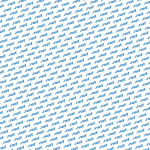The spring of the century - that's how modern sensationalist media would probably describe the early summer of 2018. However, the constant temperature records did not bode well in Austria either - there was a permanent lull for weeks on end!
I was all the more relieved to finally board the plane to Kos at the beginning of June. The windsurfing holiday could begin! The direct flight to Kos, which takes two and a half hours from Vienna, is not only easy for windsurfers who are used to travelling long distances, but also for families. When we left the airport at 7.00 a.m. local time, we were excited to discover the unspoilt nature of a small Greek island in combination with promising windsurfing conditions.
Kos itself is really small and the spots can all be reached within an hour. We decided to start in Kefalos, the bay in the south of the island that is particularly popular with shallow water fans - there are also well-equipped surf centres there as a starting point. If there was an encyclopaedia entry for "windsurfing in Greece", the bay of Kefalos would probably have to serve as an explanation: Constant wind, deep blue sea and a small white church overlooking the bay from one of the offshore islands.
As the wind is still a little weak when we arrive so early in the morning, we take our first trip into the bay with a foil - this new windsurfing discipline can now also be tried out here. In the afternoon, however, the reliable summer wind for which Greece is so famous - the Meltemi - sets in. In many places on Kos, too, this wind is strengthened locally, either by a local thermal or due to the canalisation between the countless islands of the Aegean.
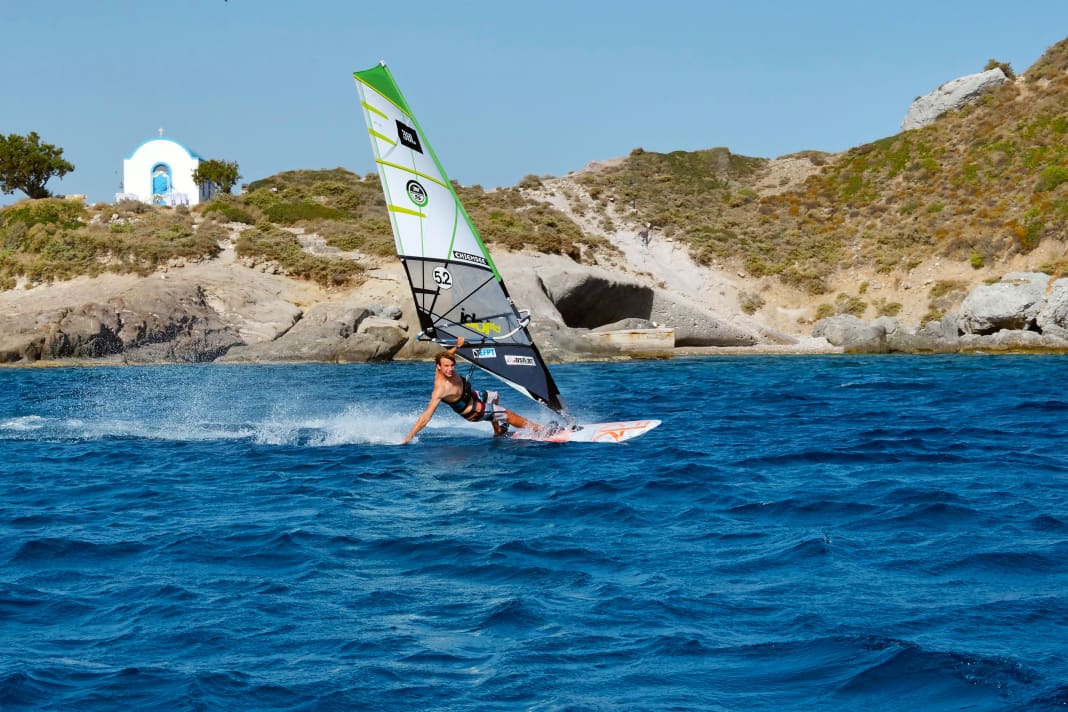





After a few relaxed strokes on the water, we treat ourselves to a little refreshment and refreshment in one of the tavernas right on the beach. Windsurfing, sun, gyros - can the day get any better? Yes, because the wind picks up even more and we get the small sails and freestyle boards ready to go. Neos? No way! A pair of boardshorts is all we need. The wind is relatively constant and the water is surprisingly flat - so we windsurf into the sunset.
In the evening, station manager Jens from Kefalos Windsurfing takes us to one of the traditional tavernas. For 15 euros you can get a full menu here, prepared with love by an old Greek couple - simply amazing. We stay in Kefalos for a few days, windsurfing, foiling and SUPing through the bay, trying out the numerous restaurants. It was already a successful trip, but we wanted to discover more spots, so we headed north and quickly ended up at the station owner "Beat" in Marmari.
The wind is constant here on the long sandy beach, the water colours look as if they were taken from a tour operator's photoshopped catalogue. The wind picks up noticeably stronger right in front of the centre and while the surfers further upwind still lack propulsion on moderate wind days, the surfers in front of the Marmari Windsurfing Centre are already gliding relaxed over the bathtub water. Beat, originally from Switzerland, has lived on Kos with his family for several years and knows the island like the back of his hand. He runs his centre with the same love with which he performs his manoeuvres and loops on the crystal-clear water.
Because Beat has recognised that Greece has a problem with the flood of plastic bottles, he tries to do his bit on a small scale: every day he fetches fresh spring water from the mountains for his station guests, ice-cold and fresh from nature.
The sessions in Marmari are also great fun because you can sometimes windsurf here in the company of giant turtles, an experience that is somehow awe-inspiring.
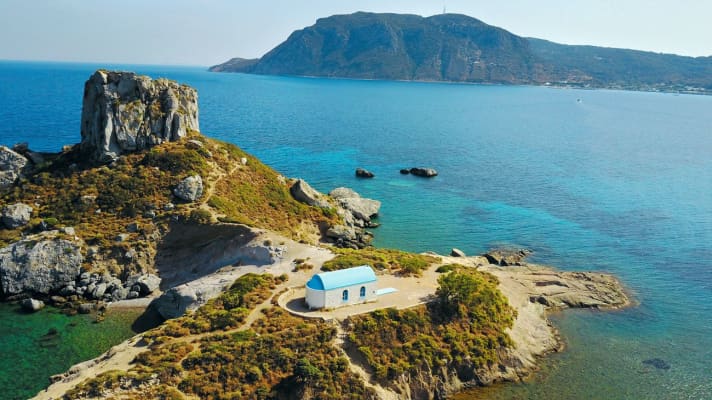
Towards the end of our Kos trip, we visit Psalidi, a town in the far east of the island that somehow looks familiar to me from the media. A little later, Spiros, a classic Greek with deep brown skin, black hair, a few worry lines on his forehead and a smoky voice, tells us over a classic café frappé, a kind of iced coffee, how bad the situation was here a few years ago: several thousand refugees landed here during the height of the refugee crisis.
In addition to all the drama and the suffering of the refugees, the people of Kos were also in a difficult situation: the constant negative headlines put many tourists off visiting the island altogether and Spiros still vividly remembers how he and his team cleaned the beach of countless cheap life jackets and broken inflatable boats every day to make it usable again for the centre's guests. Today, you no longer notice any of the drama as you relax in the shade of the lush parasols and ponder which sail to put up.
The wind here in Psalidi is side- to side-offshore, the small waves are more fun than scary and the proximity to Kos town also allows for the odd party outing.
At the end of our trip, we really only want one more thing: a day at Theologos, the island's famous wave spot. Both Jens and Beat have raved to us about this pearl of a spot, its powerful surf and sideshore wind. Unfortunately, it takes a few days with a strong northerly wind to enjoy this spot and it doesn't materialise until we check in at the airport in Kos a few days later. Ultimately, these are all just luxury worries, as the last few days of our windsurfing holiday fly by: with good sessions, great scenery, nice people and good food. And as we sit on the plane back home, where the spring of the century has now turned into a summer of the century, we realise how good this stay at the spa has really been.
General information:
Journey: Compared to other Greek islands, Kos has one major advantage - thanks to the international airport, you can travel directly to the island without having to change planes in Athens with airlines such as Condor, Eurowings and other holiday airlines. The flight takes around three hours and most spots can be reached within 20 to 30 minutes from the airport. The transfer from the airport to the spot/hotel is possible either by regular buses, but these take over an hour to get from the airport to Psalidi. If you want to make things easier for yourself, you can book through the surf tour operator Surf & Action Company ( www.surf-action.com ) and Sun & Fun ( www.sunandfun.com ) can also book complete packages. If you want to bring your own equipment, you should check the luggage regulations of your airline, register your surfing luggage in advance and pre-book a transfer from the airport. Even though Kos is not a camping paradise, travelling by camper van is certainly possible. There are regular ferries from the harbours in Piraeus and Rafina, the journey takes between eight and eleven hours. A good overview of the connections, including to other Greek islands, can be found on the booking portal www.goferry.de
Wind, weather & neoprene recommendation: Even if the statistics show July and August as the best wind season, Kos can also be worth a trip in the low season - especially as experts claim that the wind frequency in autumn has improved noticeably in recent years. The temperatures in late summer, especially when there is no wind, are no longer quite as merciless as in midsummer and the Meltemi, that reliable wind blowing from the north to north-west, still blows at more than twelve knots on an average of 40 to 50 per cent of days. It usually starts moderately in the mornings and is suitable for upwind winds, and then picks up noticeably in the afternoon - over 25 knots are not uncommon. Between July and September you should surf in shorts or shorties, a lycra against the sun is definitely more important than a warm wetsuit. Only in autumn and spring should you bring a long 4/3 wetsuit. Suitable wind forecasts can be found at www.windfinder.com/forecast/kos_kefalos , or under www.poseidon.hcmr .gr. Due to local reinforcements, e.g. the jet effect with offshore islands or the Turkish mainland, you can often add a few knots to the forecast as soon as the wind direction is right - a forecast with twelve knots NNW can be a really windy day with over 20 knots.
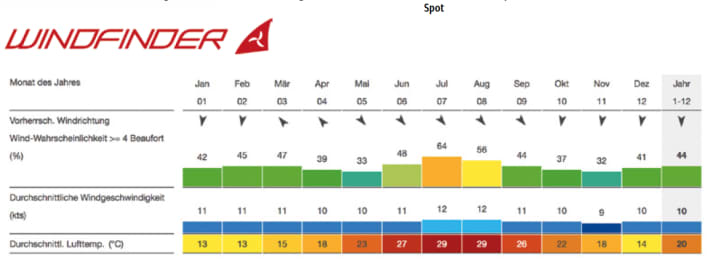
Living & Camping:Kos does not have an official campsite. As wild camping is prohibited in Greece and is also penalised in the high season, Kos is less suitable for travelling with your own motorhome or camper than Paros or Crete, for example, which have the corresponding infrastructure. There are plenty of accommodation options within walking distance at the top spots such as Kefalos, Marmari or Psalidi, and in many places you can do without a hire car. Child-friendly pools, play facilities and childcare are standard in many hotels, which is not the only reason why Kos is considered one of the best family destinations.
Surf centre:If you come to Kos, you can safely leave your own equipment at home. At all top spots such as Marmari, Kefalos or Psalidi (with the exception of the wave spot Theologos), there are well-equipped surf centres with a large selection of the latest equipment. Children's equipment is also available in many places.
Kefalos:
Kefalos Windsurfing: www.kefaloswindsurfing.com
Fun2Fun: www.fun2fun-kos.com
Daidalos:
Robinson Club Daidalos: www.robinson.com
Psalidi:
Big Blue Surf Centre: www.bigblue-surfcenter.gr
Anemos Windsurfing: www.anemoswindsurf.gr
Windzone Surf Club: www.windzone-kos.gr
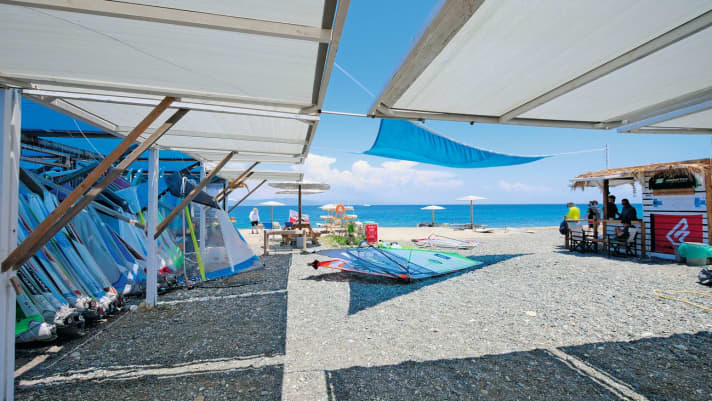
Marmari:
Windsurfing Kos: www.windsurfingkos.com
Marmari Windsurfing Centre: www.marmari-windsurfing.com
Fun2Fun: www.fun2fun-kos.com
Shops:There is no surf shop, so if you need a replacement, you should ask at a surf centre.
Alternative programme: Kos Town is the cultural centre (and also the party stronghold) of the island. The old town with its small alleyways, tavernas and bars is absolutely worth seeing and is also easy to explore by bike. If you don't want to drive, you can also take the shuttle bus. Another highlight is the Embros thermal baths, where you can relax muscles tired from surfing in the hot springs.
Downsides: As everywhere in Greece, it can get brutally hot in the height of summer, especially when the cooling Meltemi takes a break. The excessive use of plastic bags is particularly noticeable on beaches with onshore winds; doing without them in the supermarket would be a small, sensible contribution that every surfer can make.
The best windsurfing spots on Kos
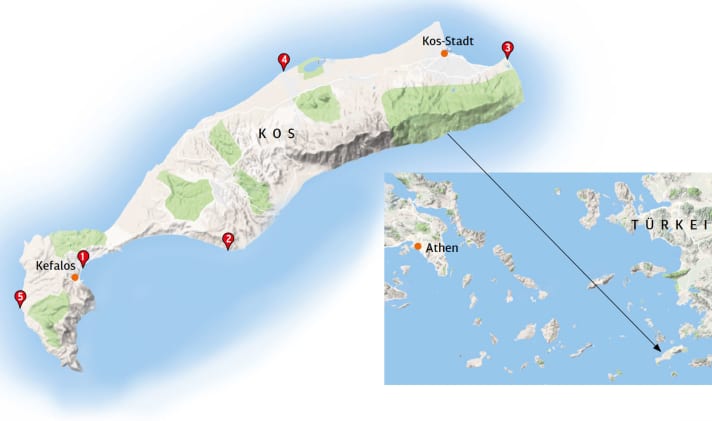
1 Kefalos
One of the top spots on Kos is undoubtedly Kefalos in the south of the island. Despite its offshore direction, the Meltemi wind from W to NW is surprisingly constant here and smooths the water in the large bay wonderfully - perfect for heating up, practising tricks or jibing. In the mornings, beginners and intermediates also get their money's worth with mostly weaker winds, before it gets windier in the afternoon. There is a jet effect at the western end of the bay, where the wind picks up noticeably. From the reef (marked with a flag), the wind is surprisingly constant and the water is still wonderfully smooth even relatively far out. When the Meltemi is strong, you can also glide close to the shore, but normally you first have to go out a little to get a clear wind. Due to the offshore wind direction, you should not overestimate yourself here - if you are unsure, it is best to register at one of the surf centres, which are equipped with lifeboats. S to SW winds can also be surfed in Kefalos, which even brings waves - but this wind direction is very rare in summer. The fact that you can stay close to the spot in Kefalos (e.g. at the Scallin Inn or Royal Bay) and that there are well-equipped surf centres is not only good for families.
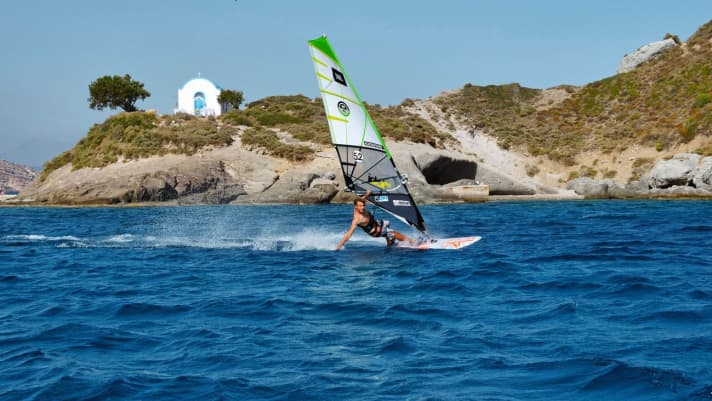
2 Daidalos
If you like it exclusive, you can have a good time here at the local Robinson Club Daidalos - but to be honest, there is no other way to get on the water here, access is reserved for club guests. If you miss this spot, you'll be able to get over it - the Meltemi is a bit gusty in the shore area, but further out you can enjoy beautiful freeride conditions with moderate chop.
3 Psalidi
Kos experts claim that the Psalidi spot on the east coast has the best wind statistics on the island. Due to the local jet effect between Kos and the nearby Turkish mainland, you can always add a few knots to the wind forecast here. The Meltemi arrives slightly offshore from the left, creating uncomplicated freeride conditions on the water with small choppy waves. Further out, a nice swell can form in strong winds, inviting experts to jump around. Despite the cross-offshore wind direction, Psalidi remains a safe spot where even intermediates can practise safely thanks to the surf schools equipped with lifeboats. The fact that kitesurfers have their own surf zone further upwind also contributes significantly to relaxation, as there are usually no turf wars here. The beach in Psalidi drops off relatively quickly and there are some rocks in the water in the shore area - shoes are definitely recommended for those who want to go upwind. Here, too, you have the option of staying directly at the spot and not having to leave your car at the Surf Hotel Andromeda. Speaking of "leaving the car behind": Kos town with its beautiful old town, bars, restaurants and clubs is only a few kilometres away - there are regular shuttle buses directly in front of the hotels.
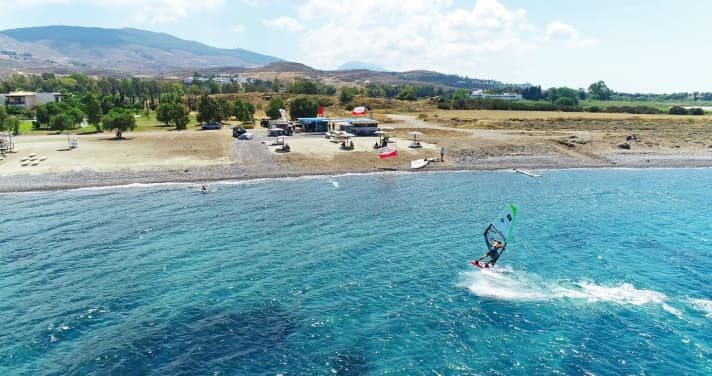
4 Marmari
The next top spot on the island, Marmari, is on the north coast and works with both classic Meltemi and the pure westerly wind, which is actually quite unpopular in Greece. Both W and NW are thermally amplified in Marmari - often by more than ten knots. So don't be put off if only twelve knots are forecast again! The special thing about this spot is the beautiful long sandy beach, which you wouldn't necessarily expect given the otherwise rather rugged nature. In contrast to Kefalos or Psalidi, the Meltemi from the W-NW does not blow offshore here, but rather diagonally onshore - so drifting is basically impossible. There is also some standing room near the beach. The wind is often slow to get going here in the morning, so upwind sailors should take advantage of this time. Towards the afternoon, the summer wind picks up and 20 knots plus X are not uncommon, nor are swells of 1.5 metres. Even though Marmari is not a real surf spot and the waves roll very moderately over the sandbank, this spot is still the best recommendation for anyone who wants to do more than just flat water surfing on holiday, but also wants to lope around. Marmari also scores points as an ideal family spot with its well-equipped surf centres and short distances between the spot and accommodation (e.g. Life Marmari Beach or Hotel Palladium).
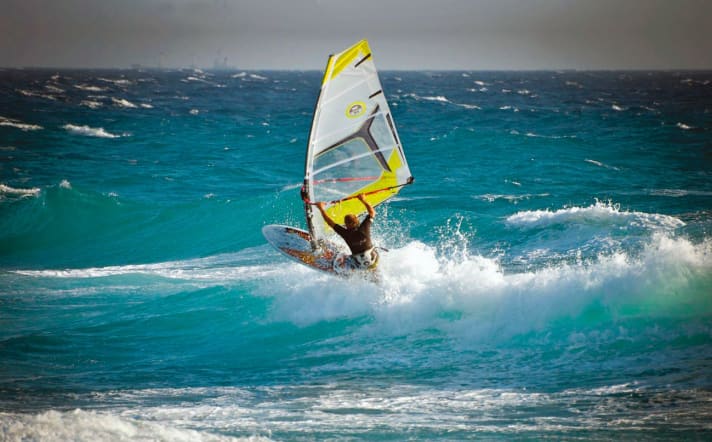
5 Theologos
Kos also has an ace up its sleeve for fans of "real" waves - the wave spot Theologos on the west coast of the island. It is possible to get to the water's edge and there are plenty of parking options, but there is no other infrastructure, which is why this spot is reserved for individual travellers with their own equipment. For Theologos to get going, the Meltemi must blow relatively northwards, preferably from the NNW, for several days. If this is the case, a surf wave up to two metres high rolls onto the beach. Ideally, the wind blows almost sideshore from the right, making the ramps equally suitable for jumps and frontside riding. Depending on the wind direction, however, there may be a slight wind cover in the shore area or in the surf zone, and the rocky entry and the noticeable current also require wave experience. If you have this experience and catch one of the days of the year when everything fits, you will realise that the Aegean can also offer surprisingly good wave conditions.

